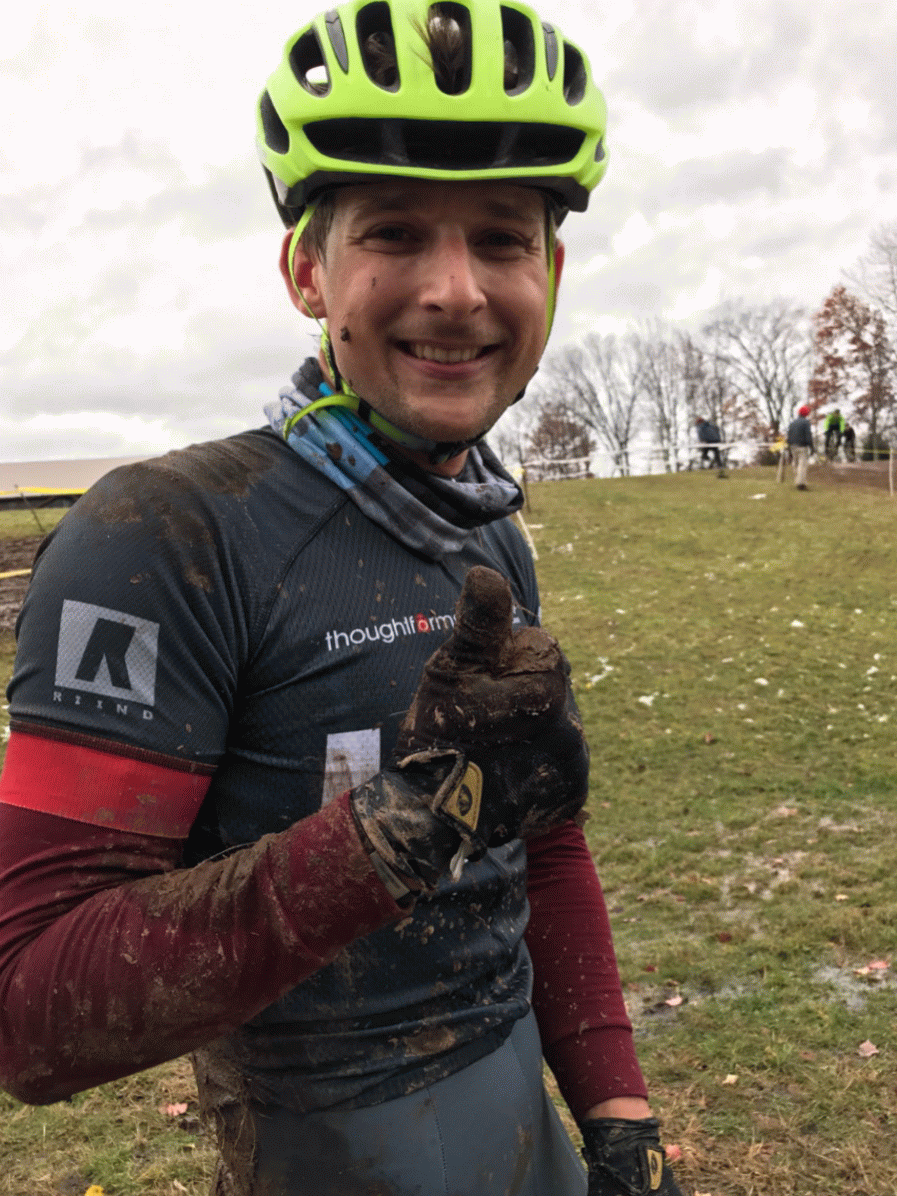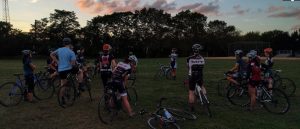The Eastern Collegiate Cycling Conference’s Cyclocross (ECCC:CX) season spans close to two months in the fall of every year: from mid-October until early December. This year’s collegiate CX calendar was very similar to the previous one: It started with two races in New Hampshire (Hanover CX and Pumpkincross), followed by HPCX in New Jersey (hasn’t been a collegiate race in a few years); then NohoCX (formerly CSI); then the Supercross Cup in Suffern, New York (with a new venue); then the Thanksgiving weekend race in Fitchburg, MA; and, finally, the Eastern Collegiate Cyclocross Championships at NBX in Warwick, RI. The only thing after that was Nationals, which took place in convenient driving distance at Riverside Park in Hartford, CT.
MIT Cycling was represented at every single one of these races; mostly with only two riders (Julie and myself), but peaking with six eager souls on the final weekend of the season. Here is a short breakdown of the highlights of the season, which was dominated by warm and dry conditions (with a few exceptions).
Late September, we welcomed some special visitors: Oliver and Claudia from Biognosys, one of our amazing sponsors, stopped by and Oliver joined me in participating in a Wednesday Night Super Prestige (WNSP) training race.
While some individual riders’ training plans may have started earlier in the year, the official kickoff for our team happened late September with two 3-hour long CX skills clinics lead by CX legend Adam Myerson (Cycle-Smart). Cyclocross newcomers and veteran riders alike learned, unlearned, relearned, and tweaked skills ranging from dis- and remounts, to efficient carrying and shouldering, to choosing lines through corners, and cleanly riding off-camber turns.
These clinics sent us well-prepared into the races: Julie, participating in the UCI/Elite races, raced herself to the top of the collegiate “Women’s A” podium in almost every single race; I competed in the collegiate “Men’s A” field for the first time and also consistently gathered points for the team (however, at a much smaller scale). Dmitro and Emma earned points on two race weekends. And Kate and Laura celebrated their CX debut with great results in the final two races.
Out of the 11 individual race days across 5.5 race weekends (Fitchburg was only a single-day event), I want to highlight two races that stood out to me:
- Supercross Cup in Suffern, NY: This race took place at a new venue this year (Rockland Community College). First impression: Very wide and hilly course, with some very fast descents, a lot of off-camber sections, and lots and lots of climbing. What made this race particularly special was the weather: On Saturday we raced in dry conditions with temperatures around 70 degrees. The course, which was mostly on grass, was fast and best suited to good climbers. Sunday’s race on the other hand was on the same course, but mostly reversed – this includes the weather. The conditions couldn’t have been more different to Saturday’s: temperatures had dropped to around freezing over night and it had rained and snowed (and kept snowing lightly on and off during the day), the course very quickly turned into a crazy mud-fest. It was cold, muddy, windy, and wet – simply put: just beautiful! Due to setup of the course, completely new challenges emerged: long sections of off-camber were not rideable due to the slippery mud; lines kept disappearing in he mud from one lap to the next; lines weren’t accessible due to course tape blowing into the course; long run-ups and deep muddy straights turned into a fitness challenge. Great race! Let’s hope the venue allows the race to come back next year! Julie was able to heroically take the Collegiate Women’s A podium on both days. I ended up 15th (Sat.) and 16th (Sun.) in the Men’s A field.
- NBX / ECCC:CX Easterns: As mentioned earlier, we had six racers participating in this final race weekend. In addition to the usual CX-squad, this included two CX-newcomers (but experienced MTBers), Laura and Kate, as well as two racers who attended the NohoCX race as well, Dmitro and Emma. Laura (first CX race!) and Dmitro shredded the course on their mountainbikes, passing other riders on many rooty technical sections of the course. Kate, starting from the very back (first CX race!), rode to the top of the Collegiate Women’s B podium on day one; a mechanical in the final lap of Sunday’s race moved her back to place four in Collegiate Women’s B of the day. Emma raced herself to the top of the podium in both her races. And finally, Julie earned 1st (Sat.) and 2nd (Sun.) of the Collegiate Women’s A podium.
Finally, here are the ECCC:CX omnium results of our team — after a full season of racing. First, the highlights:
1) Julie van der Hoop took the women’s A collegiate podium in the season overall; AND
2) MIT Cycling ended up 3rd in the combined omnium of this season. This is a particularly great result considering that (a) the team was represented by only two racers for most of the race calendar (with Julie accumulating the majority of the points) and (b) the top spots on the podium being taken by much larger teams with high attendance throughout the season.
Here are the overall season results for all participating riders:
- Julie van der Hoop: 1st of 14 in Women’s A (11 races)
- Tobias Ehrenberger: 14th of 32 in Men’s A (10 races)
- Emma Edwards: 12th of 28 in Women’s B (3 races)
- Dmitro Martynowych: 25th of 45 in Men’s C (3 races)
- Kathryn Lawrence: 13th of 28 in Women’s B (2 races)
- Laura Treers: 27th of 28 in Women’s B (2 races)
“What about Nationals?“, I hear you ask. “Incredible” is my one-word answer.
With Nationals taking place in New England’s Winter (first week of January), it was to be expected that the weather has the potential to make the races interesting. And that’s exactly what happened. Nationals took place over the course of almost a week, starting on Tuesday with open races, collegiate races on Wednesday and Thursday, some other races on Friday and Saturday, and ending on Sunday with the Elite races. While the overall course layout stayed largely the same over these six days (some sections were taken out, depending on conditions), the course surface was completely different every single day:
- Heavy rain all of Tuesday quickly turned all grass on the course into slushy and wet mud. A steep downhill section became a spectator-friendly slip-and-slide extravaganza.
- Wednesday morning (our race day!), the rain had stopped and temperatures had risen to close to 50 degrees; Tuesday’s wet mud had turned into deep and sticky mud that clung to every part on your bike, especially parts that you didn’t want it to stick to: pedals, rim brakes, and drive trains. Many sections became unrideable for mortals like me; yet carrying a bike weighing three times its normal weight didn’t make these sections much easier. For obvious reasons, riders having the luxury of a pit-bike switched bikes twice a lap, thereby avoiding two long muddy sections of the course by riding through the double-entrance pitand collecting a clean bike as reward for this smart choice. Due to these challenges the race organizers cut a few sections of the course during the day to avoid short 2-lap races in the later part of the day.
- On Thursday, things were different again: Temperatures had dropped well below freezing and all the ruts in the muddy ground had frozen overnight. These ruts made for a bumpy ride and riders had to be careful to keep their front wheels out of trouble. Needless to say, many riders flatted, and many more were sent to the ground. On the bright side, lap times were much faster again; so previously removed sections of the course were added back in.
- Friday’s conditions were similar to Thursday’s, but a bit colder.
- On Saturday, snow built up on the course over the course of the day.
- And Sunday, the elite riders had to battle a generally abused and frozen course, topped with ice, snow, and a bit of mud here and there.
Again, pretty much everyone had expected challenging conditions, but nobody expected that the challenges would be different ones every single day. Kudos to the organizers!
Julie’s and my race took place on Wednesday in the muddiest of conditions. After my race (43rd – mud mud mud, and challenges as described above — what more can I say?), I had my first experience being part of a pit-crew. Julie had a great start and stayed in the top 5 for the entire race. We made sure she could switch to a shiny mud-free bike every half lap and she was able to round out her career as an MIT Cycling racer by finishing fourth in her race. In the Nationals Omnium, MIT Cycling took place 14 out of 38 schools attending (bear in mind we only had two racers attending).
Finally, I want to direct you to all the pictures I (and others) took at races this season: Google Photos. For some races I even mounted my GoPro — here’s my playlist:
What now? MIT Cycl(ocross)ing will be training until the leaves start falling and the days get shorter again. Hope to see you at some races in the fall!
Stay muddy!




